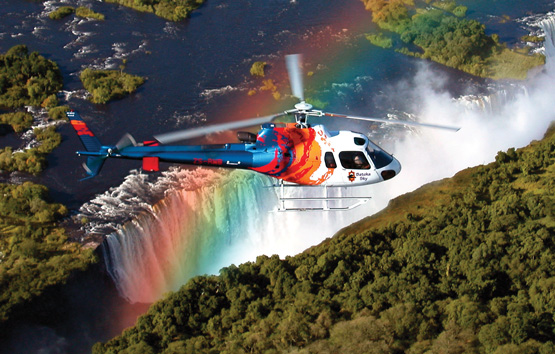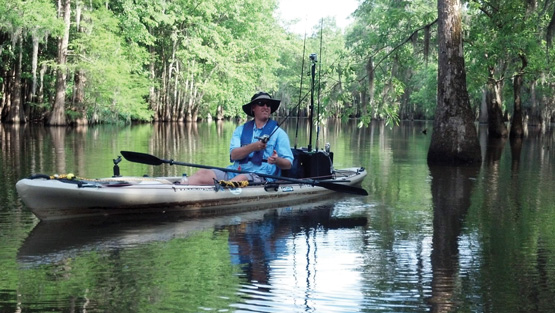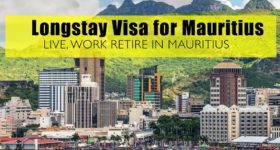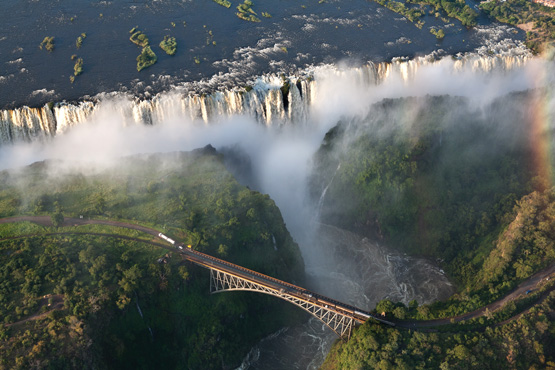
An aerial view of Victoria Falls: Zambia’s main tourist attraction
Blessed with one of the seven natural wonders of the world and an abundance of wildlife, water and vast open spaces, Zambia offers unforgettable holidays exploring the real Africa. Acknowledged as one of the safest countries in the world to visit, Zambia’s welcoming people live in peace and harmony.Here you’ll find some of the finest Safari experiences on the planet. Face to face encounters with Nature at it’s most wild. Spectacular waterways provide a delightful, adrenaline pumping or leisurely playground of activities for all ages…
As one of southeast Africa’s lesser-known gems, Zambia offers some of the continent’s finest and most hands-on tourism opportunities. Zambia is most famous for its less ‘zoo-like’ national parks that offer walking safaris and more spontaneity in viewing wildlife; the most famous park is South Luangwa. Although travel in Zambia can be difficult due to long distances and lack of infrastructure, outstanding national parks and an abundance of outdoor activities make Zambia an ideal destination for the adventure-minded traveller. Zambia also provides spectacular views of the world-famous Victoria Falls – one of the seven wonders of the natural world, canoeing on the Zambezi River, and a handful of urban tourism opportunities, such as the Livingstone Railway Museum and the homestead of the country’s liberation leader and first president, Kenneth Kaunda in Lusaka.
David Livingstone in 1855 was the first European to see the magnificent Victoria Falls on the Zambezi River and the Zambian town nearby is named after him. He named the falls after Queen Victoria, although the traditional African name “Mosi-oa-tunya” (the smoke that thunders) offers a much more vivid description.
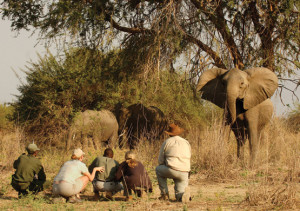
Tourists watching a herd of elephants during a game safari
Like many contemporary African states, Zambia’s borders do not reflect any historical cultural or political groupings. Rather, the state, formerly known as Northern Rhodesia, was simply an annex to Cecil Rhodes’ Rhodesia under the British South African Company and was added on both for its mineral resources and for its potential role in Rhodes’ dream of a British empire extending from ‘Cape to Cairo’. In 1953 both Northern and Southern Rhodesia were joined with Nyasaland to form the Federation of Rhodesia and Nyasaland. Soon after federation came insistent African demands for greater participation in government and resource control. Zambia gained independence in 1964. At independence despite its considerable mineral wealth Zambia faced major challenges. During the next decade it actively supported movements such as the Union for the Total Liberation of Angola (UNITA) the Zimbabwe African People’s Union (ZAPU) the African National Congress of South Africa (ANC) and the South-West Africa People’s Organisation (SWAPO).
A railroad to the Tanzanian port of Dar es Salaam built with Chinese assistance reduced Zambian dependence on railroad lines south to South Africa and west through an increasingly troubled Angola. In the mid-1970s the price of copper, Zambia’s principal export, suffered a severe decline worldwide. Zambia turned to foreign and international lenders for relief; but as copper prices remained depressed it became increasingly difficult to service its growing debt. By the mid-1990s Zambia’s per capita foreign debt remained amongst the highest in the world.
Despite its poverty, Zambia is home to a wealth of arts and cultures. Zambia has at least 35 ethnic groups and a population of some 11 million. Contemporary religious belief is about 75% Christian. Local arts include sculpture and adaptations of Congolese dance music. English is the official language and it is widely spoken. Bebma is the second most widely spoken language, followed by Lozi, Lunda, Luvale, Nyanja, Tonga, and about 70 other indigenous languages.
Travel to Zambia is possible by air into Lusaka or directly to Livingstone, location of the Victoria Falls. Overland travel is also possible by bus or TAZARA train. Road conditions within the country can be unpredictable, but overland travel is the most common way of getting around within the country. Accommodation in Zambia can range from budget hostels to luxury hotels in tourist and urban areas. The best time to travel for wildlife spotting is between August and October. This is the dry season; the wet season in March-June may provide more greenery and water for animals but will often have the adverse affect of lush vegetation which hides the wildlife. The Zambia International Fishing Competition in early March provides a unique opportunity to watch hundreds of fishermen practice long-perfected methods of fishing on Lake Tanganyika. Other festivals occur throughout the year but are not specifically dated.
Zambia stretches from the southern shore of Lake Tanganika to the shores of Lake Kariba. It is bordered by Malawi and Mozambique on the east, Zimbabwe to the south, Namibia and Angola to the west and Congo and Tanzania to the north. A large portion of the country is given over to wildlife with 19 national parks and 31 game management areas. The prime wildlife areas are the Luangwa valley and the South Luangwa National Park, Kafue National Park and the Lower Zambezi National Park. South Luangwa is amongst the most hands-on wildlife experiences that a traveller can currently partake in on the continent. Zambia is more than a stop on the way to somewhere else; it is a destination worth a longer stay.
VICTORIA FALLS
Victoria Falls are a spectacular sight of awe-inspiring beauty and grandeur on the Zambezi River, bordering Zambia and Zimbabwe. Described by the Kololo tribe living in the area in the 1800’s as ‘Mosi-oa-Tunya’ – ‘the Smoke that Thunders’.
In more modern terms it is known as ‘the greatest known curtain of falling water’. Columns of spray can be seen from miles away as 546 million cubic metres of water per minute plummet over the edge (at the height of the flood season) over a width of nearly two kilometers into a deep gorge over 100 metres below.
The wide basalt cliff, over which the falls thunder, transforms the Zambezi from a wide placid river to a ferocious torrent cutting through a series of dramatic gorges.
To fully appreciate the incredible size of the Falls, and the awesome power of the water as it carves into the deep zig zagging gorges for eight kilometres, one must see it from the air. Micro-light and fixed wing flights are available. The pilot will take you along the wide tranquil upper Zambezi, and over the huge 2 km rent in the earth. The breathtaking sight of this magnificent natural phenomena, seen in all its glory from the air, is unforgettable.
On the opposite cliff, facing the falls, you can take a well marked and paved walk through the rain forests. Every so often the path will open out into a clearing for a view of the falls. Further along this path is the Knife Edge Bridge which affords an impressive panorama depending on the time of year. Although less can be seen of the width of the Falls during the wet season, the intense spray provides welcome relief from the heat, but don’t carry anything you don’t want to get wet!
Different times of the year will provide completely different experiences of the Falls region. Peak flood season is around March and April and the full power of the falls can be experienced in all its glory. But due to the masses of spray rising from the fallen water the full width of the Falls cannot be seen on foot. The aerial view at this time however is spectacular, with clouds of spray rising high into the sky.
As the floods abate the view of the falls gets better and better through the year, but at it’s lowest, around November and December the Falls become little rivulets running over the edge. This season’s gift is the view of the impressive cliffs that form the Falls wall and the magnitude of the abyss can be fully appreciated. You can also do trips by raft to the base of the Falls in low season called ‘the float of angels”.
ZAMBEZI RIVER
Another not-to-be-missed attraction is the famous Zambezi River – Africa’s fourth largest River system, after the Nile, Zaire and Niger rivers. It runs through six countries on it’s journey from central Africa to the Indian Ocean. Its unique value is that it is less developed than others in terms of human settlement and many areas along it’s banks enjoy protected status.
It’s power has carved the spectacular Victoria Falls and the zigzagging Batoka Gorge.
The Zambezi has been harnessed at various points along the way including the massive Kariba Dam between Zambia and Zimbabwe and Cabora Bassa Dam in Mozambique. Plans for another dam at the Batoka gorge have fortunately been shelved.
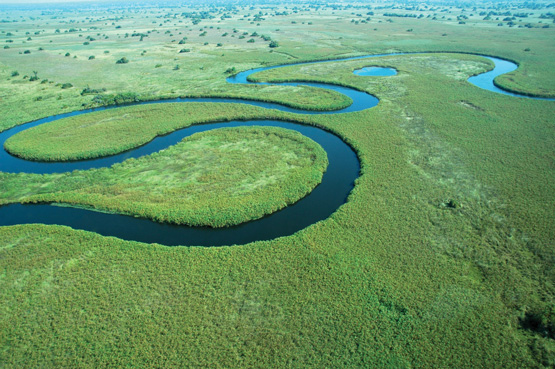
The Zambezi River meandering its way through acres of Zambian hinterland
The River’s beauty has attracted tourists from all over the world providing opportunities for a myriad of water sports and game viewing.
Running for a length of 2,700 kilometres, it begins it’s journey as an insignificant little spring in the corner of north-west Zambia in the Mwinilunga District. It bubbles up between the roots of a tree, very close to the border where Zambia, Angola and Zaire meet.
It enters Angola for about 230 kilometres, where it accumulates the bulk of its headwater drainage, and re-enters Zambia again at Cholwezi rapids flowing due south but substantially enlarged by the entry of various tributaries.
This upper part of the river is thinly populated by pastoralists, farmers and fishermen and although wildlife is sparse it is remarkably free of pollution. This is also the scene of the remarkable Ku-omboka Ceremony where thousands of inhabitants move annually to higher ground as the Zambezi floods into the low lying plains.
Lake Tanganyika
This vast inland sea was first made known to the European world in the mid 1800’s by the English explorers Richard Burton and John Speke. They pursued it as the source of the Nile, arriving at its shores in 1858, only to discover that the Ruzizi River in the north, which they thought to be the Nile, flowed into and not out of the lake. (Their incredible journey is documented in the movie Mountains of the Moon.)
Tanganyika’s waters lap Tanzania, Burundi, Congo DR and Zambia. It is the longest fresh water lake in the world and the second deepest after lake Baikal in Russia. The immense depth is because it lies in the Great Rift Valley, which also has created its steep shoreline. It reaches a depth of 1,433 metres (4,700 feet), which is an astounding 642 metres below sea level.
Landlocked Sea
It is essentially a landlocked sea but in years of heavy rain the lake overflows into the Lukuga River which in turn feeds Congo DR’s Lualaba River
Despite the ferocious surface storms that occur, driving waves up to six metres high (20 foot), no mixing of the lower relict waters occur. The bottom 1,200 metres of the lake remain ‘dead’ – either too high in hydrogen sulphide or too low in oxygen to support life. This ‘fossil water’ may be as old as 20 million years. By contrast, the oceans, because of currents and upwellings have life forms even as low as 11,000 metres (36,000 feet).
Lake Tanganyika has a remarkably uniform temperature. The lower regions are only a mere 3°C colder than the surface. The reason for this strange phenomenon has yet to be discovered.
Lake Tanganyika boasts over 350 species of fish of which most are endemic. Like Lake Malawi, Lake Tanganyika is extremely old, and the combination of its age and ecological isolation has led to the evolution of unique fish populations. Since new species are being discovered continually in these remarkable lakes, it is difficult to determine which has the highest diversity, but they at least share the distinction of being the top two lakes in the world in terms of biodiversity, whilst Lake Tanganyika has the highest proportion of endemicity, concentrated mainly in the Zambian waters of the lake.
Regarded as one of the most biologically unique habitats on earth, Lake Tanganyika is also an evolutionary showcase due to its great age and stability. Ninety eight per cent of the lake’s cychlids (which comprise two thirds of all the lake’s fish) are unique to Tanganyika. Also endemic are all seven of its crabs, five out of the thirteen bivalve molluscs, more than half of its gastropod molluscs and eleven of its thirty three copepod crustaceans.
Sport fishing is very popular here and catches include the goliath tigerfish and Nile perch. Crocodiles inhabit most of the shoreline, except around Mpulungu, probably due to the noise of people and motorboats. Swimming in the lake (in the Mpulungu area only!) is an absolute treat. Warm, clear, salt free water that changes from silky stillness, to high waves for a great body surf – usually with no apparent reason for the change. Storms from way up north probably cause the still waters in the south to agitate.
The MV Liemba, a large ex German warship that has been converted into a passenger ferry, arrives at the port of Mpulungu every Friday morning and leaves in the afternoon for Kigoma in Tanzania and Bujumbura in Burundi. If you have time to do the week long trip there and back or if en route further up Africa, this is an experience not to be missed. It’s not luxurious but the trip itself offers a spectacular experience of this vast Lake in the heart of the continent. There are ‘first class’ cabins with double bunks and one family cabin with en suite facilities. The toilets seldom work properly so be prepared. It has a carrying capacity of 500 passengers and by the time it has left Kigoma, it is usually full.
It was originally built as a cargo vessel when German occupied what was then known as Tanganyika, now Tanzania.
The First World War broke out before its completion and it was converted to a military expedition ship to be used against the British forces in Northern Rhodesia, now Zambia and the Belgian Congo, now Zaire.
It was bombed by the Belgians in 1916, raised and dragged to Kigoma where it sank again. The British, who had taken control of Tanganyika after the war, raised her from the sea bed again and renovated and restored her glory and converted it to a cargo and passenger vessel. The name Liemba was the name Livingstone gave to the Africans living in the area when he first reached the Lake.


